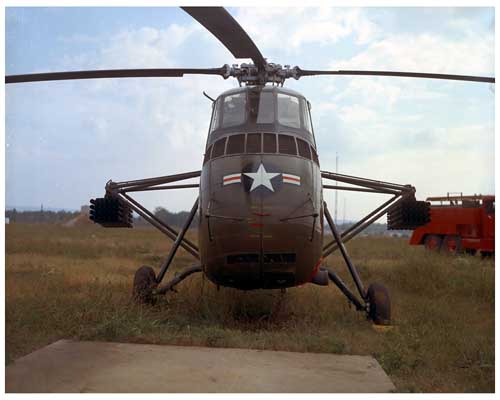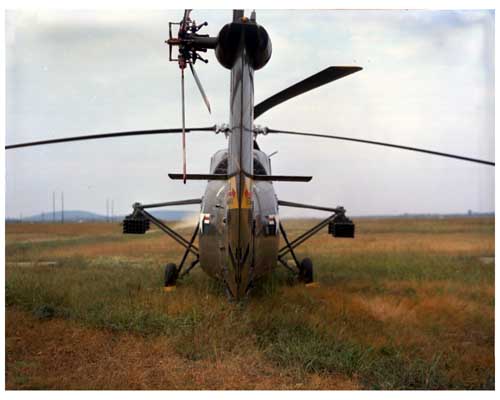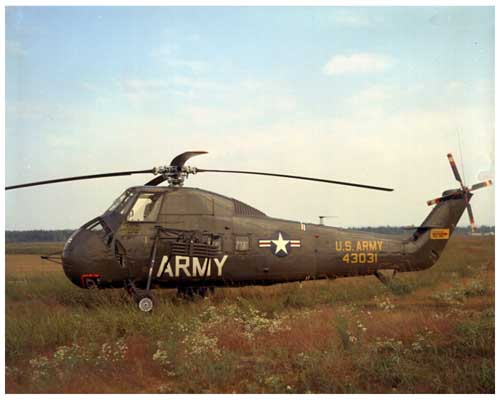Aviation Systems

AH-1 Cobra Attack Helicopter
|
(1965) The UH-1 "Huey" was too slow for the gun ship or escort role. Bell Helicopter won the competition for an interim fast armed escort helicopter while the Army was waiting for the fielding of the AAFSS Ah-56A Cheyenne. The AAFSS program was cancelled in 1972. Bell designed the Cobra using the best features of the UH-1C gun ship. The Cobra uses the basic transmission, modified "540" rotor system, and power plant of the UH-1C, a streamlined fuselage using parts 85% in common with the UH-1D tail boom and body, combined with the nose components from the experimental Bell (model 207) Sioux Scout. The original Bell (model 209) featured an Emerson chin-turret mounting two 7.62mm "Miniguns" and had fully-retractable skids. The AH-1G Cobra featured a computerized stability-augmentation system, in place the short weighted gyro-stabilizer bar originally used on the Bell (model 47) OH-13 Sioux. The AH-1G was powered by a single Lycoming T53-L-13B 1400 shp engine.
The Bell (model 209) AH-1G Cobra featured a new wide-bladed rotor and slim fuselage that gave it twice the speed of the UH-1B "Huey". It could could loiter over the target area three times as long, and had an improved armament system over previous gun ships. Tandem seating of the two crew members the Cobra, with a width of just 38 inches, presented a much smaller target than the 100 inch wide UH-1 "Huey". The Cobra had a two-bladed semi-rigid seesaw bonded all metal main rotor and two-bladed rigid delta hinge bonded all metal tail rotor. The AH-1G Cobra's mission was direct aerial fire support, armed escort, and reconnaissance.
The AH-1G Cobra, or "Snake", was armed with 2.75 inch (70mm) Folding Fin Aerial Rockets (FFARs) in M158 seven-tube or M200 19-tube rocket launchers, and a chin-turret on the M28/M28A1 armament subsystem. The chin-turret mounted the M134 7.62mm "Minigun" and the M129 40mm grenade launcher. The AH-1G could also be armed with a single M134 "Minigun" in a XM64 (TAT-102) chin-turret, the M134 "Minigun" in fixed side-mounting M18/M18A1 gun pod, and the port (left) side mounting M195 20mm automatic gun on the M35 armament subsystem. The AH-1G could also mount the M118 smoke grenade dispenser.
|

AH-1 Cobra
|

H-21/CH-21 Series Shawnee assault helicopter
(1949). The H-21 Shawnee was the fourth of a line of tandem rotor helicopters designed by Piasecki. The Boeing Vertol (formerly Piasecki) H-21, commonly called the "flying banana", was a multi-mission helicopter, utilizing wheels, skis, or floats. It was used for Artic rescue because it performed so well at low temperatures. The CH-21 also served with the U.S. Air Force (as the "Workhorse"), the French Navy, the Royal Canadian Air Force and the West German Air Force. The French used an armed version of the CH-21 in Algeria, mounting guns in the door ways and on the skids. The CH-21B assault helicopter could carry 22 fully-equipped troops, or 12 stretchers, plus space for two medical attendants, in the MedEvac role. The CH-21B was first deployed to Vietnam in December 1961 with the Army's 8th and 57th Transportation Companies, in support of ARVN (Army Vietnam) troops. The CH-21B/CH-21C Shawnee could be armed with 7.62mm or 12.7mm door guns. The CH-21 was relatively slow. It's cables and fuel lines were so vulnerable to small arms fire it was even rumored that a CH-21 had been downed by a Viet Cong spear. The Shawnee was the "Workhorse" of Vietnam until 1964 when it was replaced with the fielding of the UH-1 "Huey" in 1963, and the later fielding of the CH-47 Chinook in the mid-1960s. The Shawnee had two tandem fully-articulated three-bladed counter-rotating rotors. The CH-21 was powered by one Curtis-Wright R1820-103 Cyclone supercharged 1150 hp piston engine. The CH-21B was equipped with an uprated 1425 shp engine. The CH-21 had a speed of 128 mph (111 knots).\
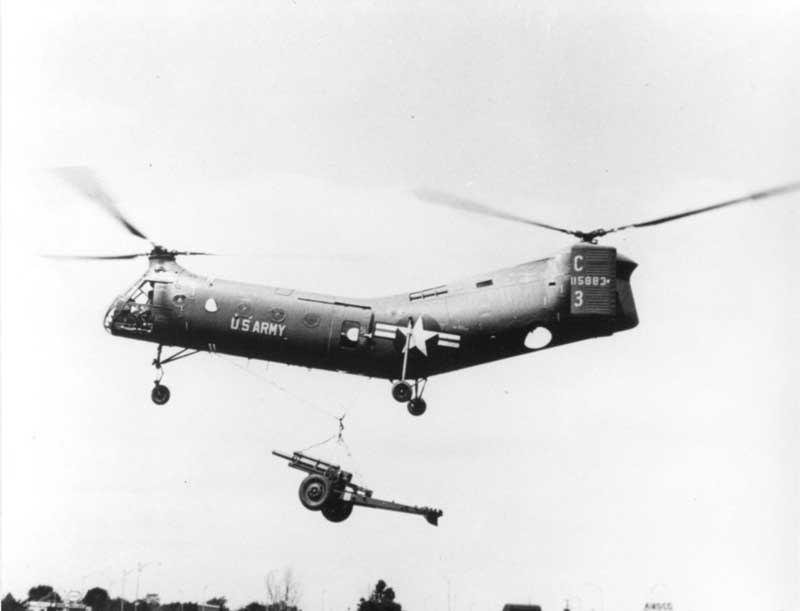
H-21 Shawnee
|

CH-34 Chocktaw cargo and light tactical transport helicopter
(1954). The Sikorsky (model S-58) CH-34A/CH-34C, essentially a lengthened and more powerful version of the Sikorsky (model S-55) H-19 Chickasaw cargo helicopter, could carry 12 to 16 troops. It could carry eight litters in the MedEvac role. The U.S. Marine Corps version, UH-34, was the primary Marine utility/assault helicopter used in Vietnam. The Sikorsky (model S-58) was licensed and built in Great Britain as the "Wessex". The Chocktaw had a single four-bladed main rotor and a four-bladed metal tail rotor. The CH-34C was powered by a single Curtis-Wright R-1820-84C 1425 hp piston engine and had a speed of 123 mph (107 knots).

CH-37 Series Mojave medium cargo helicopter
|
(1953). Initially procured in 1956, the Sikorsky (model S-56) CH-37A/CH-37B, with a crew of three, was a large medium lift transport helicopter. Clam shell doors in the nose provided access to a cargo compartment that could accommodate two jeeps or a 105mm howitzer. The Mojave could carry 26 troops or 24 litters in the MedEvac role. The CH-37 had a single five-bladed main rotor and a metal four-bladed tail rotor. The CH-37 was powered by two Pratt & Whitney R-2800-54 2100 hp pistons engines and had a speed of 131 mph (114 knots). It was used for aircraft recovery in Vietnam.
|
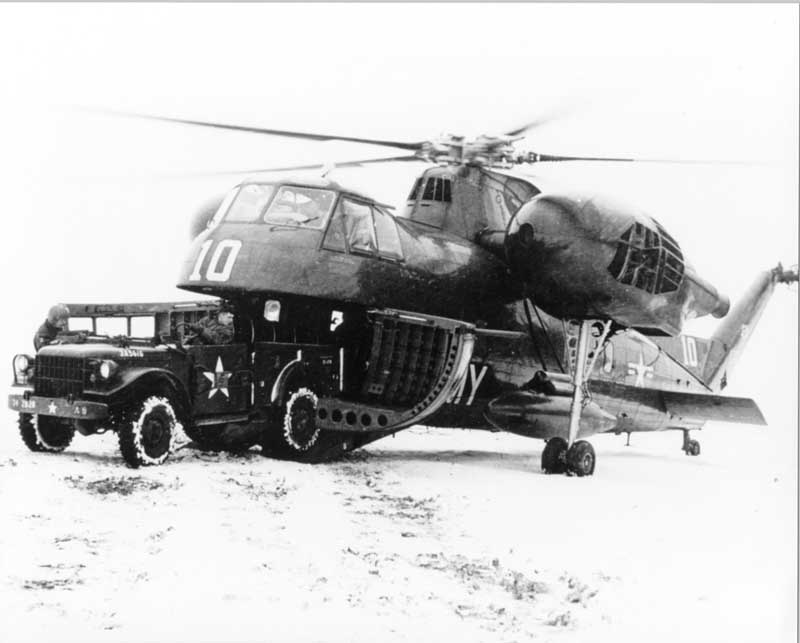
CH-37 Series
|

CH-54 Tarhe heavy lift helicopter
|
(1962) The Sikorsky (model S-64A) CH-54A/CH-54B Tarhe "Skycrane," with a crew of three, was designed for heavy internal or external lift of heavy bulk loads. It had a rear-facing pilot's seat to provide a clear view of the cargo. A hoist was provided to allow pickups and deliveries without landing. A lightweight van (universal pod) could be attached to the fuselage for use as a mobile command post, maintenance and repair shop, or as a Mobile Army Surgical Hospital (MASH). The field hospital was equipped with X-Ray, lab equipment, and blood bank. It was well lighted and air conditioned so surgery could be performed where ever it was needed. A "people pod" was designed to carry 45 combat-ready troops. The "Skycrane" served with the 1st Cavalry Division in Vietnam. The CH-54 was used in aircraft recovery operations when loads were too heavy for the CH-47 Chinook. It was also useful for off-loading during ship-to-shore operations. The CH-54 could also be rigged to drop the large 10,000 lb. cratering bomb used to create landing zones ("LZs") in dense jungle. The T-54A Tahre had a six-bladed main rotor, four-bladed metal tail rotor, was powered by two Pratt & Whitney T73-P-1 4500 shp turbine engines, and had a speed of 128 mph (111 knots). The CH-54B was powered by two Pratt & Whitney T73-P-700 4800 sph turbine engines.
|
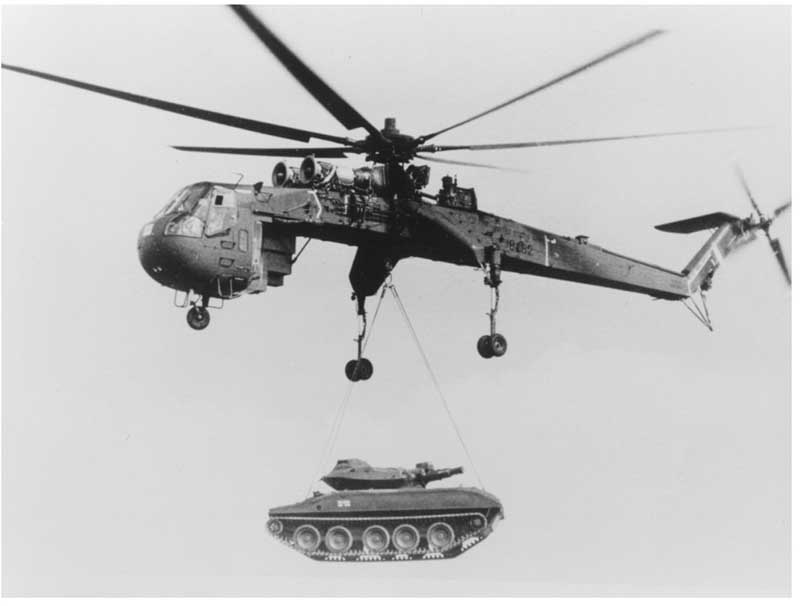
CH-54 Tarhe
|
|

Curtiss-Wright Air Car
|
A four-place Ground Effects Machine (GEM) designed by the Curtiss-Wright Corporation to skim six to 12 inches off the ground at speeds up to 35 mph. Two of these machines were bought “off-the-shelf” for research.
|
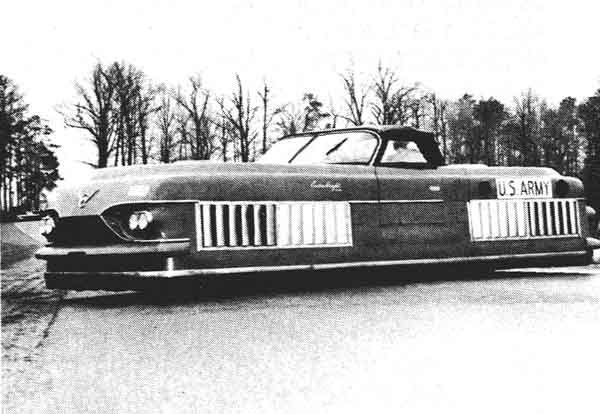
Curtiss-Wright Air Car
|

CV-2 Caribou
|
Since its initial procurement in November 1959 and the first delivery in January 1961, the Army purchased 173 Caribou before releasing them to the U.S. Air Force in April 1966 under a Army-Air Force agreement. The CV-2's were ferried to Vietnam in 1962 where their excellent short-field performance and their three-ton payload served well. In 1966, the DOD later approved a twin-turbine, wide fuselage program.
Manufacturer: DeHavilland Aircraft of Canada
Power Plant: Two Pratt & Whitney R2000-7M2 engines (1,450 hp each)
Propellers: Hamilton Standard three-bladed, variable pitch metal propellers
Specifications: Span: 95 ft, 8 in. Length: 72 ft, 7 in. Ht: 31 ft, 9 in. Empty wt: 16,920 lbs. Gross wt: 28,500 lbs. Places: Crew of two and 32 pass., 24 combat-equipped troops, or 14 litters and 8 troops.
Performance: Max speed (SL): 216 knots. Cruise speed (SL): 149 knots. Service ceiling: 27,500 ft. Max range: 1,611 n.m. Rate of climb: 1,575 fpm.
|

CV-2 Caribou
|

H-25A Army Mule light cargo helicopter
|
(1953). The Piasekci H-25 was an eight-place tandem rotor helicopter developed for the U.S. Navy for naval rescue operations. With minor modification, it met Army needs for a light cargo and utility helicopter. The maximum Army inventory reached 63 in 1955. All inventory aircraft were later turned over to the U.S. Navy. The H-25 had two three-bladed counter rotating rotors. The H-25 was powered by a single Continental Motors nine-cylinder radial R-975-46 475 hp engine and had a cruising speed of 92 mph (80 knots).
H-25A Army Mule
|
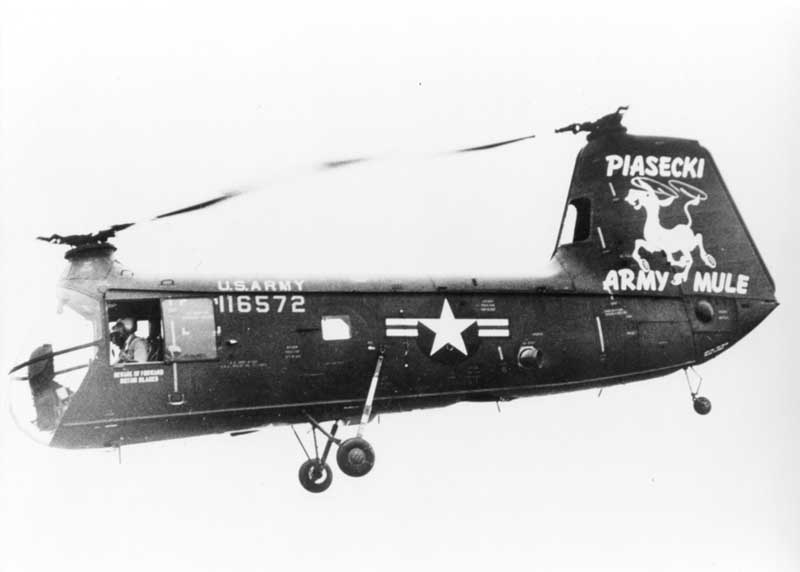
H-25A Army Mule
|

H-23/OH-23 Series Raven light observation helicopter
|
(1948) The 4-place Hiller H-23 was based on the U.S. Navy UH-12, which was first flown in 1948. The H-23 Raven performed as a utility, observation, and MedEvac helicopter during the Korean war. Model numbers ranged A through D, F and G. The H-23A had a sloping front windshield. The H-23B was used as a primary helicopter trainer. Beginning with the UH-23C, all later models featured the "Goldfish bowl" canopy similar to the Bell model 47, and also featured the Bell-designed short weighted gyro-stabilizer bar. The OH-23 had a speed of 97 mph (84 knots). The Raven had a two-bladed main rotor, a metal two-bladed tail rotor. Both the OH-23B and the OH-23C were powered one O-335-5D engine.
The OH-23D was a purely military version with a 0-435-23C engine and a more reliable transmission. Most OH-23Ds were replaced by the OH-23G, the most common version of the Raven, with a more powerful Lycoming O-540-9A six-cylinder, horizontally opposed, air cooled 305 hp engine. The OH-23G could seat four. The MedEvac version carried two external skid-mounted litters or pods. The Raven saw service as a scout during the early part of the Vietnam war before being replaced by the OH-6A Cayuse in early 1968. The Raven could be armed with twin M37C .30 Cal. machine guns on the XM1 armament subsystem or twin M60C 7.62mm machine guns on the M2 armament subsystem. The XM76 sighting system was used for sighting the guns.
|

H-23/OH-23
|

0-1 BIRD DOG
|
DESCRIPTION: Two-place all-metal, wing observation, reconnaissance, liaison aircraft with tandem seating.
MANUFACTURER: Cessna Aircraft Company, Wichita, Kansas.
POWER PLANT: One Continental 0-470-11 piston engine rated at 213 horsepower.
PROPELLERS: McCauley fixed pitch, two bladed metal propeller.
SPECIFICATIONS: Span: 36 ft. Length: 25 ft, 10 in. Height: 7 ft, 4 in. Empty wt: 1,614 lbs. Gross wt: 2,430 lbs. Fuel: 40 gal. Flaps, fixed landing gear.
PERFORMANCE: Max speed (SL): 101 knots. Cruising speed (SL): 100 knots. 170 knots. Stalling speed: 86 knots. Service ceiling: 18,500 ft. Max range: 681 n.m. Endurance: 4.67 hours. Rate of climb: 1,040 fpm.
REMARKS: Developed for the Army after WW II, the Bird Dog (originally designated by the Army as the L-19) was Cessna’s winning design competition entry in April 1950. The Army accepted some 3,430 0-1A’s and E’s by March 1964 with the USMC using 0-1B’s and 0-1C’s. Later, the USAF utilized F’s and G’s in Vietnam for forward air controller missions. Nineteen other countries also purchased this versatile aircraft. The structurally stronger T0-1D served as the Army’s instrument trainer version in having a variable pitch propeller and an instrument panel in the rear. The latter could be enclosed for hooded flight.
|
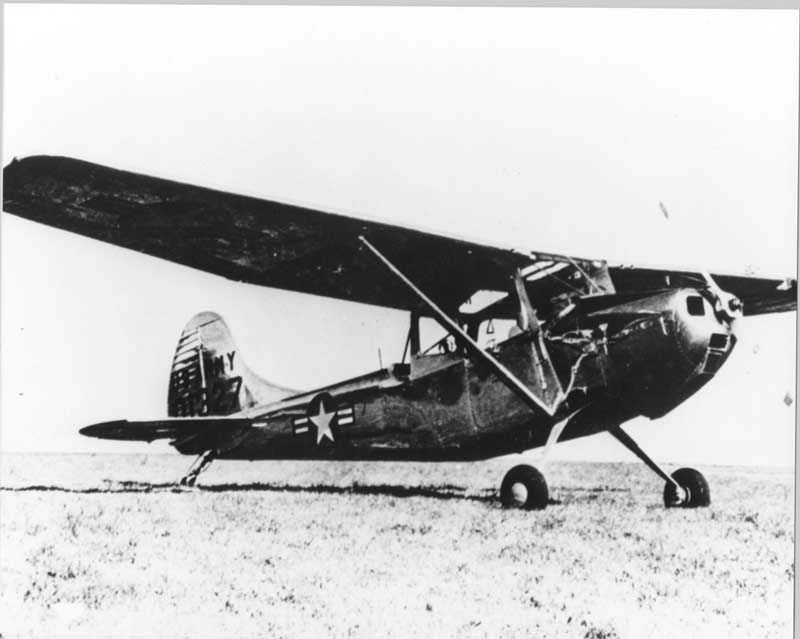
0-1 BIRD DOG
|

OH-6A/HO-6 Cayuse light observation helicopteroh-6
|
(1963) The Boeing (McDonnell Douglas) (formerly Hughes model 369) OH-6A was designed for use as a military scout during the Vietnam war to meet the U.S. Army's need for an extremely maneuverable light observation helicopter (LOH program). Initially fielded in Vietnam in early 1968, the Hughes OH-6A was used for command and control, observation, target acquisition, and reconnaissance. The Cayuse was organic to division, brigade, and battalion size units. The four-passenger teardrop shaped "Flying egg" (six-passenger with rear seats folded-down) was a small, light, sturdy, maneuverable helicopter, with very low drag.
The OH-6A Cayuse was quite effective when teamed with the AH-1G Cobra attack helicopter as part of what were known as "Pink Teams". The OH-6A "Loach" (for "LOH") would find targets by flying low, "trolling for fire", then marking the target with colored smoke to lead in a Cobra, or "Snake", to attack. The Cayuse could absorb an extensive amount of small arms fire and still bring the crew home safely. The OH-6A could be armed with the M27 armament subsystem, the port (left) side mounting M134 six-barrel 7.62mm "Minigun" or a 40mm grenade launcher on the XM8 armament subsystem. In addition, an M60D 7.62mm machine gun could be mounted in the rear starboard (right) door opening. The OH-6A replaced the Korean era OH-13 Sioux and OH-23 Raven light observation helicopters. The Hughes (model 500M) international military version was sold in ten countries and built under license in Italy and Japan. The Cayuse had a single articulated four-bladed main rotor and a metal two-bladed tail rotor. The OH-6A was powered by a single Allison T63-A-5A 285 shp turboshaft engine, and had a cruising speed of 144 mph (125 knots). Two special operations versions of the OH-6A are the Hughes (model 500C) AH-6 "Little Bird" armed variant, and the MH-6 transport/utility version. These advanced versions feature a quieter five-bladed main rotor, minimal-cavitation tail rotor, and a distinctive T-shaped tail.
|

OH-6A/HO-6 Cayuse
|

YR-13/H-13/OH-13 Series Sioux light observation helicopter
|
(1946) The Bell (model 47) H-13 Sioux, with a crew of three, was one of the most popular light utility helicopters ever built. The Bell model 47 was produced continuously from 1946 to 1973, and in other countries through 1976. Produced in 20 different configurations, with model numbers ranging from A to T, the Bell model 47 was used in 40 countries. The combined total of commercial and military versions of this series was 5,000. The U.S. Army Air Force procured it's first YR-13 (model 47B) in December 1946. The OH-13 had a cruising speed of 70 mph (60 knots).
An important Bell innovation during the early development of the helicopter was the use of short weighted gyro-stabilizer bar at 90° to, and beneath, the main rotor. The gyro-stabilizer bar, with streamlined counterweights at both tips, was linked to the rotor in such a way that it determined the plane of the rotor, and maintained it generally in the horizontal, regardless of the angle of the mast. The stabilizer bar, connected to the cyclic pitch control, acted as a hinged flywheel utilizing gyroscopic inertia to keep the teetering rotor blades in-plane and independent of fuselage movement due to gusts of wind, providing stability during flight. Arthur Young, Bell's designer, ensured the system had high enough inertia so sufficient energy would be stored in the rotor to permit safe autorotation in event of engine failure, an important safety consideration.
The H-13 was used for observation, reconnaissance and in the MedEvac role as a litter carrier in Korea, following initial fielding in 1951. In the MedEvac role a cocoon-like stretcher pod could be mounted on each skid. A distinctive feature of the Bell (model 47D) H-13D/H13E was the now familiar "Goldfish bowl" Plexiglas canopy, featured in the TV-series MASH (Mobile Army Surgical Hospital). The H-13 earned the nickname "Angel of Mercy" for evacuating some 18,000 United Nation's casualties during the war. The OH-13 Sioux also saw service during the early days of the Vietnam war before the fielding of the OH-6A Cayuse in early 1968. The Sioux had a single two-bladed main rotor and a metal two-bladed tail rotor. The H-13 had a speed of 106 mph (92 knots). The Sioux could be armed with twin M37C .30 Cal. machine guns on the XM1 armament subsystem or twin M60C 7.62mm machine guns on the M2 armament subsystem.
|

YR-13/H-13/OH-13
|

OV-1 Mohawk
|
DESCRIPTION: Two-place observation and reconnaissance aircraft.
MANUFACTURER: Grumman Aerospace, Old Bethpage, Long Island, New York.
POWER PLANT: Two Lycoming T53-L-701 turboprop engines, 1,400 shaft horsepower each.
PROPELLERS: Hamilton-Standard threebladed reversing & feathering, 10 ft. diam.
SPECIFICATIONS: Span: 48 ft. Length: 41 ft. Length (with SLAR antenna): 43 ft. Height: 13 ft. Empty wt: 11,800 lbs. Fuel: 1,930 Ibs; Two 150-gallon drop tanks: 2,368 lbs.
PERFORMANCE: Maximum speed (SL): 285 knots, (IA/photo). Cruise (SL): 210 knots. Service ceiling (80% fuel): 25,000 ft. Range (w/drop tanks): 890 n.m. (IA/photo).
REMARKS: The OV-1 was first purchased as the AO-1 in September 1960. The “A” utilized two 960 hp Lycoming T-53-L3 turboprop engines; a 1,100 hp T-53-L7 was installed in the “B” model in 1963. Designed to operate from small unimproved fields in the forward battle area, the “0” is deceptively similar to earlier versions but rapid configuration procedures enable a single OV-1D to perform the surveillance functions of any previous Mohawk. Capable of daylight, darkness, and inclement weather operations, the ‘D’ has a more accurate inertial navigation system, improved infrared and radar performance with automatic data annotation of imagery, three photographic systems that include a vertical and oblique firing camera and two panoramic cameras that provide vertical and horizontal terrain coverage horizon to horizon, a radiological monitoring system, and ECM equipment to assure mission success.
\
|
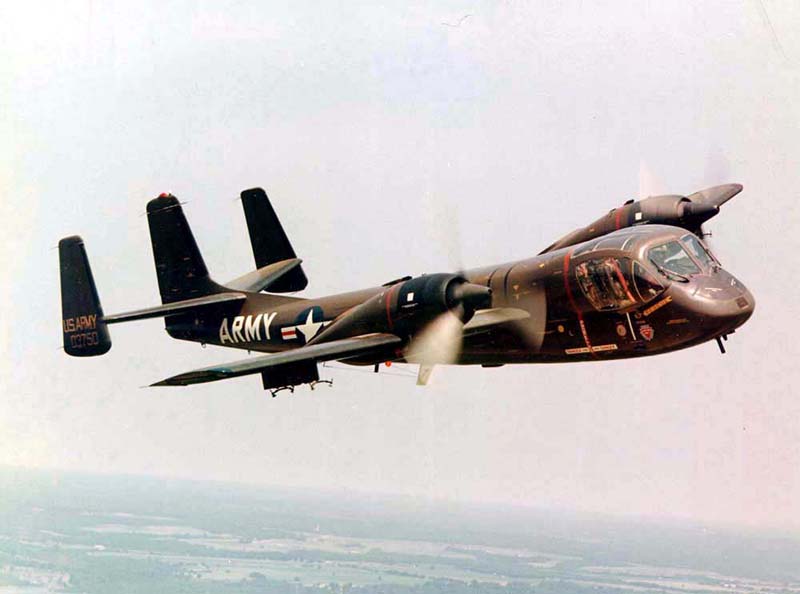
OV-1 Mohawk
|

Bell (model 204) HU-1A/HU-1B
|
The "Huey" as it was called after it's original model designation, the HU-1, was essentially a stretched Bell (model 47) Sioux with room for 7 troops or three stretchers in it's cargo compartment behind the pilot. It was redesignated as the Utility Helicopter UH-1 in 1962 under a tri-service agreement. The HU-1A Iroquois, initially procured by the Army in 1959 as a general utility helicopter, was the first model ordered in large numbers. Since 1959, the "Huey" has evolved through 13 models, A thru V. It saw wide use in Viewnam following initial fielding in September 1962. The "Huey" saw service with the 82nd Airborne Division, the 101st Airborne Division, and the 57th Medical Detachment. The "Huey" became the basis for the creation of the 1st Aviation Brigade in 1966.
"Hueys" armed with only two M60D door guns, called "Slicks" because of their uncluttered external appearance, were the backbone of all airmobile combat operations in Vietnam. Unarmed MedEvac "Hueys" were called "Dust Offs", because of the clouds of dust kicked-up, when landing. The "Huey" replaced the CH-21 Shawnee in the combat assault role. The UH-1 had a two-bladed semi-rigid metal main rotor, a two-bladed semi-rigid metal tail rotor and had a speed of 104 mph (90 knots).
The (Bell model 204) UH-1A (1956) seated seven troops. The UH-1A was powered by a Lycoming turbine T53-L-1A 860 shp (shaft horse power) engine.
The (Bell model 204B) UH-1B (1960) seated nine troops. The UH-1B featured two long FM homing antennas and the pitot tube on the nose, and a large single window in the doors. The UH-1B was was powered by several Lycoming turbine engines; T53-L-5 960 shp, T53-L-9A 1100 shp, and T53-L-11D 1100 shp. The UH-1B had a cruising speed of about 105 mph (90 knots).
The UH-1C (1965) could seat nine troops, had an improved rotor, and a greater range. The UH-1C was powered by a single Lycoming T53-L-11D 1100 shp engine. The rotor head was the "540" rotor system, used only on the UH-1C (and the UH-1M). This was the prototype of the rotor system later used, without stabilizer bar and dampers, on the AH-1G Cobra. The chord of the rotor blades (distance from the leading edge to the trailing edge) was much longer on the UH-1C than on all other model "Hueys". The UH-1C also featured a brace extending from the aft fuselage to the weapons mount. This support was only used on the UH-1C and the UH-1M, an engine upgrade to the UH-1C. These aircraft were also the only "Hueys" with the fuel filler cap located on the left side of the fuselage.
The UH-1M was a small number of UH-1C models that were upgraded to the more powerful Lycoming T53-L-13B 1400 shp engine for use in Vietnam. The first three UH-1Ms were were equipped with the INFANT (Iroquois Night Fighter and Night Tracker) system for night operations. All remaining UH-1Ms were simply UH-1Cs with the T53-L-13B engine upgrade.
The "Huey" is the most universal military aircraft of the modern era, serving in all four branches of the American uniformed services and in the armed forces of at least 48 other nations. The MedEvac version was the UH-1V.
|
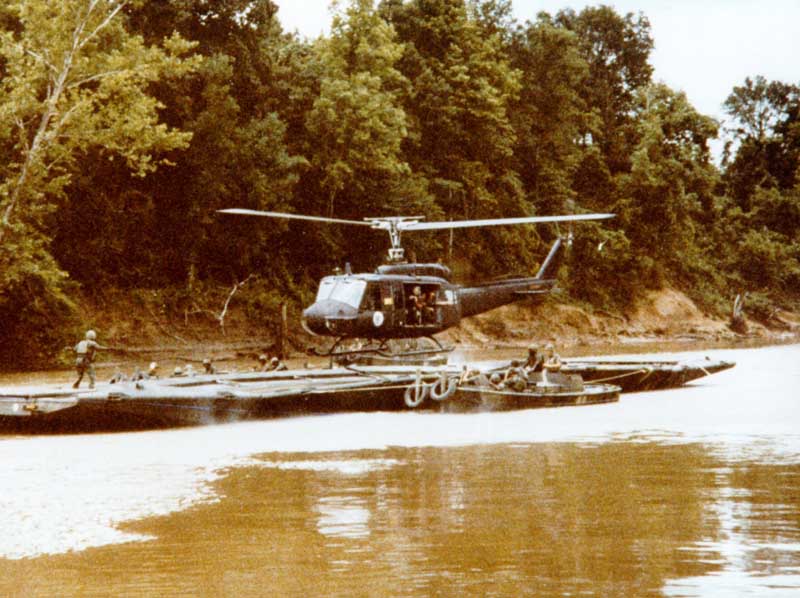
Huey
|

H-19/UH-19 Series Chickasaw utility and light tactical helicopter
|
(1949). The Sikorsky (model S-55), initially procured in November 1949, was the World's first transport helicopter. The 12-place H-19 (redesignated UH-19 in 1962), with a crew of two, served as a utility, troop carrier, and rescue helicopter with winch. Model numbers ranged from A thru D. In the MedEvac role it could carry six litters and one medical attendant. For the first time casualties could be carried and attended to under cover, within the aircraft. Two companies of H-19 Chickasaw helicopters proved the value of helicopter transport by moving cargo and personnel during the final months of the Korean war and then by participating in prisoner exchanges and other functions after the cessation of hostilities. The Sikorsky (model S-55) was licensed and built in Great Britain as the "Whirlwind". The UH-19 had a three-bladed main rotor and a metal two-bladed tail rotor. Models A thru C were powered by a single Pratt & Whitney R-1340-57 550 hp engine. Model D was powered by a Curtis-Wright R-1300-3D 700hp piston engine. The Chickasaw had a speed of 113 mph (98 knots). The UH-19D had a cruising speed of 75 mph (65 knots).
|

H-19/UH-19 Series Chickasaw
|

